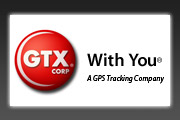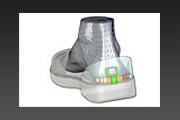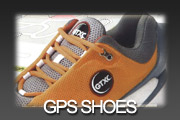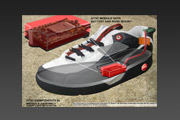Press & News
Wed. Sep. 3, 2014
GPS SmartSoles Expand into Canada
Wed. Sep. 3, 2014
GPS SmartSole Wearable Technology by GTX Corp on FairchildTV Canada
Wed. Jul. 30, 2014
GTX CORP ANNOUNCES PARTICIPATION IN C4CT SUMMIT AT THE UNITED NATIONS AND RENEWS LONG-TERM ADVISORY AGREEMENT WITH THE BREWER GROUP, INC.
Thu. Sep. 26, 2013
GTX Corp Completes Institutional Financing
Tue. Sep. 10, 2013
LOCiMOBILE Expands Distribution with Android Launch for Track My Work Force and GPS Shoe Apps
Thu. Apr. 18, 2013
GTX CORP ANNOUNCES SPONSORSHIP OF EXCLUSIVE NFL DRAFT EVENTS HOSTED BY BREWER SPORTS INTERNATIONAL
Wed. Feb. 6, 2013
Learn how the Aetrex Navistar GPS Smart Shoe can help caregivers of people living with Alzheimer's, Dementia, and Mild Cognitive Impairment
Thu. Jan. 24, 2013
GTX Corp Partners with BrickHouse Security to Bring Revolutionary GPS Tracking Shoes to Market
Wed. Jan. 16, 2013
GPS Shoes Expand into Canada
Thu. Dec. 6, 2012
Over 10,000 People in Kern County Suffer from Alzheimers
Thu. Oct. 11, 2012
Aetrex Navistar GPS SHOES for tracking Alzheimer's sufferers now available in the UK and Ireland
Wed. Aug. 22, 2012
2 New Smartphone Apps Available From GTX Corp: Track Your GPS Shoes and Track My Work Force
Tue. May. 8, 2012
GPS Technology Enhances Quality of Life for Autism due to wandering and safety issues
Wed. Nov. 30, 2011
GTX CORP RECEIVES NEW ORDER FOR 1,500 GPS DEVICES FROM AETREX WORLDWIDE AS GPS SHOES BECOME AVAILABLE ONLINE TO CONSUMERS
Wed. Nov. 9, 2011
GTX Corp Reports 250% Increase in Revenue for Third Quarter 2011 with the GPS Shoe Launch, Increased App Users and the Lifespire Code Amber Alertag
Sun. Nov. 6, 2011
GPS Shoe - Top News Story
Tue. Nov. 1, 2011
These shoes weren't made for wandering
Sun. Oct. 30, 2011
Bay Area Expert Weighs In On GPS Shoes For Alzheimer's Patients
Tue. Oct. 25, 2011
GTX Corp Ships First 3,000 GPS Shoe Devices to Footwear Partner Aetrex Worldwide, Inc.
Wed. Oct. 19, 2011
GTX Corp Expands Partner Alliance in Preparation for GPS Shoe Launch
Wed. Sep. 21, 2011
GTX Corp announces October availability of its GPS Tracking Shoe
Mon. Sep. 19, 2011
Interview with Patrick Bertagna, CEO, GTX Corp
Thu. Apr. 28, 2011
GTX Corp GPS Smart Shoe Expands into Australia and New Zealand with Tracking Central Pty Ltd.
Wed. Apr. 6, 2011
GTX Corp Introduces GPS Smart Shoes to China Revenues up 68%
Wed. Feb. 9, 2011
GTX's New Patent...Smart Shoe Has Heart In Its Sole (GPS)
Tue. Oct. 12, 2010
GPS Smart Shoe Wins 2010 Peoples Choice Award
Tue. Oct. 5, 2010
Costs of Alzheimer's will touch 1% of Global GDP in 2010
Tue. Sep. 21, 2010
GPS Smart Shoe Nominated for Most Innovative Location Device
Sat. May. 29, 2010
Keeping track of seniors with Alzheimer's
Wed. Mar. 24, 2010
GTX Corp and Aetrex Worldwide, Inc. Sign Licensing Agreement to Deliver Patented GPS Shoes Worldwide
Wed. Mar. 24, 2010
GTX Corp. Inks Global Licensing Deal with Aetrex Worldwide
Fri. Mar. 19, 2010
GPS Shoes Help Care for Alzheimer's Victims
Wed. Mar. 17, 2010
GPS-powered trail running shoes may be on the horizon
Sun. Feb. 28, 2010
GTX Corp® awarded broad U.S. Patents for its innovative and potentially life saving GPS Shoe technology.
Sat. Feb. 20, 2010
GPS Shoes Featured in SGI
Wed. Jan. 27, 2010
GTX Corp and its subsidiaries unveil State of the Union and 2010 Roadmap
Fri. Jan. 15, 2010
Haiti: an inconceivable catastrophe has exposed the narrow crack in the Earth's social crust between despair and hope.
Mon. Dec. 28, 2009
New GPS Tracking App by LOCiMOBILE hits over 15,000 Downloads and makes iTunes Top 25 List in first 2 weeks!
Mon. Nov. 30, 2009
GTX Corp signs licensing agreement for Code Amber, a wholly owned subsidiary, to launch new patent pending digital ID tag and service
Tue. Sep. 29, 2009
GTX Corp awarded broad U.S. patent for its innovative life changing GPS enabled Shoes
Tue. Sep. 1, 2009
Shoe with GPS implant helps track loved ones with dementia
Tue. Aug. 11, 2009
GPS-Equipped Shoes Keep Track of Wanderers
Keeping track of seniors with Alzheimer's
Dealing with Senior's who walk off.
May 29, 2010
The e-mail alert shouted its message: "Missing Person with Alzheimer's. PLEASE HELP." It was sent to Alzheimer's Assn. chapters and to law enforcement officials within hours after an Orange County woman disappeared while on a short trip to visit a friend.
The woman had set out in her car, made a wrong turn and became confused, says her family, who asked that her name not be used to protect her privacy.
During the next two days, she zigzagged her way across two states, making one wrong turn after another, putting ever more miles between herself and her home as she headed east.
"She had a cellphone, but it wasn't turned on," says her daughter, Susan. "It was a nightmare."
The 86-year-old woman had been diagnosed with Alzheimer's disease, but her wrong-way journey shocked her family because until then, she had been able to function normally.
As soon as Susan called the Alzheimer's Assn. to report that her mother was missing, the organization began sending out alerts asking Good Samaritans who saw the woman to contact MedicAlert + Safe Return, a 24-hour nationwide emergency response service for individuals who wander.
The woman, meanwhile, was still at the wheel, driving south to San Diego, then east to Tucson. Finally, she pulled over to the side of the road and asked an Arizona state trooper how to get to California. He directed her to west Interstate 10. Several hours later she was stopped near Indio by a California Highway Patrol officer, who contacted her family.
"She's doing fine now," says Susan. "We took away her car and license, of course."
That story has a happy ending, but many confused seniors who become lost are never found again. The Alzheimer's Assn. estimates that 60% of individuals with Alzheimer's will wander at least once during the progression of the disease. Up to 70% of these individuals wander more than once, and up to several times. One study reported that nearly half of those not found within 24 hours die — usually from dehydration, exposure or injury.
"It's a scary situation for families who have a relative who wanders," says Dr. Lisa Gibbs, a UC Irvine geriatrician who directs the school's Health Assessment Program for Seniors. "It's easy for the person to get lost and hurt. They're also very vulnerable to people who might want to take advantage of them."
Products such as MedicAlert + Safe Return offer families a way to track lost loved ones: It's one in a burgeoning field, with dozens of devices on the market and new devices and products popping up all the time. Most tracking systems are GPS-based, using the same technology that's found in car navigation units.
Television commercials for the devices, called family trackers, have become commonplace; they are aimed primarily at parents who worry about their children wandering away during an outing. A small device can be stowed in a child or adult's pocket, purse or backpack; some are incorporated into wrist bands. They range in price from $100 to about $400, with monitoring costs of up to $80 per month. Most can be purchased online.
At the low end of the technology spectrum is MedicAlert + Safe Return, http://www.medicalert.org/safereturn, an inexpensive program endorsed by the Alzheimer's Assn.
The product consists of an engraved wristband or dog tag that contains information about the wearer. One call to the number written on the band activates a community support network to help reunite the lost person with their family. When a person is found, a citizen or law enforcement official can call a toll-free 24-hour emergency response number, and the individual's family or caregivers are contacted, as in the Orange County woman's case. Costs are $24.95 to set up a plan and an additional $25-a-year fee.
The downside? A Good Samaritan has to see the tag and be able to get close enough to read it. The upside: In the Southland, 160 people have been found because of the Medic Alert + Safe Return tag, according to Jane Dickinson, Alzheimer's Assn. representative. The product also includes the Alzheimer's Assn. e-mail alert system, which was triggered when Susan's mother was reported missing.
Comfort Zone, another product endorsed by the association, is similar to other GPS devices on the market, except that it was designed primarily for people who have dementia. Family members can program it to operate in several ways: In early stages of the disease, it can be used to track a person in a car. In later stages, it can be converted to a bracelet. Alerts are sent to caregivers via computer or text messages. Costs are $199 to $299 to purchase the device, $45 for activation and $45 to $79.99 in monthly monitoring fees.
"What complicates search and rescue for individuals with Alzheimer's disease is that, unlike a lost child, many will not respond to calls to them, nor will they call out for help," says educator Andrew Carle. "They often also become quickly frightened and attempt to hide — making locating them more difficult." Carle, an assistant professor at George Mason University in Fairfax, Va., specializes in aging and senior housing issues.
A problem inherent with many of the devices is that they can be removed: A patient with dementia might take off a bracelet or remove a device from his or her pocket, Carle says.
"Paranoia is a manifestation of the disease, so people with AD will often remove anything placed on them with which they are unfamiliar — for example, a 'clip on' or other distinct device. For the same reason, they are also adept at getting around locks, alarms or other devices intended to stop them — and, once having done so, are difficult to find."
Carle's personal favorite among the monitoring systems on the market is scheduled to be released for retail sale this summer: GPS Shoes. The shoes, which will be sold at http://www.foot.com, (800) 526-2739, will contain a tiny embedded tracking device. Whenever the wearer wanders off more than a pre-set distance, the caregiver will receive an alert by telephone and computer.
The Aetrex Ambulator GPS Shoe will retail for $200 to $300, with monthly tracking available for $22.95 to $39.95, says Patrick Bertagna, chairman of GTX Corp., which builds the tracking device that will be embedded in the shoes.
The device will work anywhere there is cell coverage. If Susan's mother had been wearing the shoes when she departed on her 500-mile journey, her family might have found her more quickly.
This column on caring for, and staying connected with, aging family members appears monthly. Comments: [email protected]
Copyright © 2010, The Los Angeles Times
Introducing...
 GPS SmartSole™ |




















